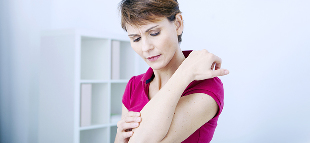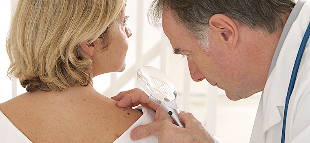Psoriasis is not infectious disease a chronic disease, in the majority of cases affects the skin of the facies (less nail plate, hairy part of the head). It manifests itself excessively dry red spots, they act a little above the surface of the skin (papules). By joining, papules form plaques that are the sources of chronic inflammation.

Psoriasis is passed or not?
In response to a question, it is contagious psoriasis or not, you must understand that the disease is not transmitted nor sexual, nor in the air-drip, no contact, or in some other way. Become infected with it is impossible.
As A result of the violation of a process of exfoliation of the Horny scales on the body are the dry areas. Die for them, no, but the ill experience serious physical discomfort due to their appearance.
Causes of psoriasis
Up to now it is not known exactly why it occurs, psoriasis. There are different theories of the evolution of the disease. The specialists are inclined to what the defeat of the skin and nails can cause:
- the stress, the emotional;
- endocrine pathology;
- hereditary predisposition;
- an error in the functioning of the immune system, because that violates the processes of growth and division of epithelial cells.
Autoimmune cause of psoriasis is that the immune cells of the T-helpers and T-killers, in the norm responsible for the protection of the body against tumor cells, pathogens, viruses and bacteria begin to penetrate the upper layers of the epidermis. Here we produce substances that activate the inflammatory process. As a result, the skin cells start to divide and multiply. It is observed proliferation.
The development of psoriasis is possible, and the whole of the action of various factors, given below the list:
- It is very thin and poorly wet the skin (sebum is produced little).
- The frequent contact with irritating compositions – cosmetic of poor quality, by alcohol solutions of the chemical goods.
- Too often, washing the body, the hands (especially if you use a harsh scrubbing pad and soap/shower gel).
- The abuse of alcoholic beverages.
- The development of infectious diseases, caused by staphylococci, streptococci, fungi.
- The treatment with antidepressants, lithium carbonate, beta-blockers, anti-malarial and anticonvulsant medications.
- The change of the climate zone.
- Mechanical injury in the skin.
- The tendency to allergic reactions.
- The infection by the hiv.
Classification of the disease
If you look at the different pictures of psoriasis in the initial phase, differences are noted – there are several types of this pathology dermatological. Depending on the place of defeat is:
- Psoriasis of the scalp (manifests itself with itching, bleeding in the skin).
- Psoriasis of the nail (nail plate slowly detaches from the bed and becomes painful, it formed red spots).
- Ladonno-plantar psoriasis (a disease common only in their feet and/or palms of the hands).
- Psoriasis (dry plates appear in different parts of the body).
- Arthropathy psoriasis (amazed at the joints).
- The gender of the psoriasis (disease covers the skin of the genital organs).
Clinical forms of psoriasis:
- Ordinary or vulgar. It is manifested planes of pink-red papules of small size, that rise slightly on healthy skin. The top of papules covered with clear scales, which begin to diverge even with a light touch. If the psoriasis treatment is started late, the small bulbs are combined in large.
- Exudative. It is more common in people with obesity, hypofunction of the thyroid gland, diabetics. The symptoms of psoriasis of this form the following: papules are bright red, above them are displayed with yellow-gray scales. The plates affect the folds of the skin – axillary cavity, the area under the breasts in women. The patients complain of itching, burning.
- Seborrheic. Psoriasis occurs in the head, the folds of the throat in the form, between the shoulder blades, in the chest. The boundaries of the spots are not clearly differentiated. Peeling of the silver-yellow. If you look at the photo of psoriasis on the head, some association with the common fungal disease, such as dandruff.
- Ladonno-plantar. The disease is common in people 30 to 50 years whose work is related to the heavy manual labor. If in this way we can observe and rashes on the body.
- Pustular. In the body to form pustular elements. In medicine distinguish one type of pustular forms of psoriasis Tsumbush. It is idiopathic (primary) - in the skin bubbles appear, which are transformed into pustules. The pustules are disclosed and dried. Later, they appear typical of the disease, peel eruptions. As well as secondary benign current. In this case, abscesses occur on the surface of the typical psoriatic of platelets by the irritant action of the drugs.
- Another type of pustular forms of psoriasis barbera. He only affects the soles and the palm of the hand. In the skin appear purulent pustules. They are not revealed, over time they become a little dark dried bark. Psoriasis barbera distinguishes the symmetry of defeat.
- Arthropathy (joint). The severe form. Common in patients who have a skin rash. Typically occurs after five to six years after the onset of the first symptoms of the disease, if the treatment of psoriasis was illiterate. The pathology of the joint system may be different from non-expressed arthralgia, do not lead to changes in articulation of the device, to deform ankylosis (the joint becomes completely immobile).
- Psoriatic erythroderma. It is the consequence of that is vulgar or exudative psoriasis. It consumed almost all of the skin. Red, studded with a large amount of dry scales. Increased body temperature, increased lymph nodes (especially of the hip and inguinal). If the patient is not aware of how to cure psoriasis, the possible loss of hair, brittle nails.
According to the criterion of seasonal relapse of psoriasis can be divided into:
- years of age;
- winter (the most common);
- indeterminate.
The symptoms of psoriasis
Of dominant of the symptoms of psoriasis depends on the treatment, therefore, in the first admission, the doctor performs a comprehensive examination of the patient, studied in depth the place of localization of psoriatic foci.
Often the disease is manifested during the winter. In summer, under the influence of the solar radiation, the signs of psoriasis may disappear completely. However, when the "summer" the way of the pathology of exposure to the sun, by contrast, should be avoided. In the period of exacerbation of the patient complains of very strong itching. The defeat of nail plates occurs only in 25% of patients.
When the disease of the skin of the head the hair will not be involved in a pathological process. Starts to flaking of the skin. With the time, the area of eruptions can be "pull" in the area of the neck, behind the ears. The inflammatory process was very rapid division of keratinocytes.
When psoriasis of the palms and the stop of the horny layer becomes thicker and is covered by deep cracks. The photo of psoriasis in the initial stage of the sample patches of transparent color content. Later, they become white, and become the darkness of the scars.
As to the nail plate, the most common are two types of injuries:
- The nail of a finger covered dimples, which apparently are similar to the marks of the punctures ("thimble").
- Finger nail changes color and begins to crack, which resembles the disease with fungicide. Through the nail plate varies psoriatic papule, surrounded by a red ring.
The stage of psoriasis
Despite the fact that they are still arguing about what is psoriasis and specifically what may cause its appearance, the phase of the disease as well studied. The three:
- Progressive (initial). On the surface of the skin appearing neoplasms in the form of eruptions on the skin, with a tendency to the growth of the periphery. Apply on the healthy skin, and form oval or rounded plaques. The spots are pink or red. Flaky the crust is still no whitish scales. The edges of the foci of a little sealed. As a result of scratching appear new eruptions.
- Fixed. Begins through one-to-four weeks after the first symptoms of the psoriasis. The plates become more clear. New eruptions do not appear, old – slowly resolve. It points to the healing of papules in the direction from the center to the edges, so that their form becomes void. All of the surface healing of the foci is covered with white scales.
- Down (cushioned). The color of the psoriatic platelets is practically indistinguishable from the healthy skin. Minimizes the itching. Around the foci of the shape of a "neck Voronov", which is a ring of dense Hot layer of the skin. If the patient uses the quality of the ointment of psoriasis, the stage of the regression lasts about a month. In the opposite case, the process of "damping" can take up to six months.
The task of a patient who was diagnosed with psoriasis – all the time to keep the disease in remission.
If you suffer from similar symptoms, immediately consult your doctor. It is easier to prevent a disease than to deal with the consequences.
How is the diagnosis of psoriasis

The diagnosis of psoriasis takes care of a dermatologist. The procedure is based on the outside of the inspection, the assessment of the condition of the skin and nails, the study of the location of the foci. An additional analysis with obvious symptoms are not appointed. If you have difficulties with the diagnosis, a sample of skin with inflamed of the plot (biopsy), who are studying in the lab.
When the complaints of pain in the joints is performed the x-ray. It is also assigned to a blood test to make sure that there are no other types of arthritis. To exclude a fungal infection the test is performed with the use of hydroxide of potassium.
How to cure psoriasis
The treatment of psoriasis is complex. Includes:
- general therapy;
- local therapy;
- physiotherapy.
Before you determine to cure psoriasis, the doctor dermatologist, determines the phase of the disease, the clinical form, the prevalence of process. When the appointment of the drugs takes into account the patient's age and the existence of comorbidity. In general, first formed the most safe for the health of the drugs that are characterized by the least number of side effects. If you do not provide the transition of the psoriasis in the phase of regression, the treatment is adjusted.
The system of medicines in psoriasis
The drugs that are taken in the interior, help the medium and heavy stages of psoriasis. Them concern:
- Vitamin A derivatives (retinoids). Reduce the speed of maturation of keratinocytes. Normalizes the differentiation and maturation of cells.
- Immunosuppressants. Reduce the activity of T lymphocytes, which leads to increased division of the cells of the epidermis.
- Drugs for the treatment of malignant tumors. Inhibit the spread and growth of atypical cells of the skin.
Physical therapy in psoriasis
Physiotherapy procedures can significantly improve the well-being of the patients of psoriasis. In some cases, are allowed to waive in full of drugs. Be used more often:
- The balancing of phototherapy. Affected skin of the irradiated uv rays. with a wavelength of 280-320 nm. Is assigned 15 to 35 procedures.
- Photochemotherapy (puva-therapy). The method involves the shared use induced photosensitizer in the interior and the length of long wave uv radiation for external use. The ultraviolet rays penetrate deep into the skin of the water, and photosensitizer blocks the process of dna synthesis of the cells of the skin, reduces the speed of your division. The course duration is of 20 to 30 procedures.
- The therapy with laser. Uses a laser with wavelengths. Laser provides acceleration of the resorption of platelets, precludes the formation in their place of scars.
- The use of monochromatic ultraviolet radiation. Each focus alternatively processed tube/a laser source of uv rays. Healthy skin does not affect. The method is more optimal, if it affected less than 10% of the skin. The duration of treatment is 15 to 30 sessions.
- Electric. It is soft impact of the electrical impulses in the brain during 20-60 minutes. As a result, the patient calms down, normalizes the functioning of the central nervous system, psoriatic plates begin to dissolve.
- LINKS-therapy. It is decongestant, antipruritic and analgesic tool. Accelerates the reabsorption of the scar. If necessary, can be combined with phonophoresis. To achieve therapeutic effect should be performed 7 to 14 sessions.
- The magnetic therapy. Exercises society-sanea the effect on the body. Reduces inflammation, reduces itching, and burning, help to eliminate pain in the joints.
- Treatment with bee venom. With the help of the electrophoresis apparatus or the ultrasound in the body, it enters the bee venom. It is characterized by the resolution and the anti-inflammatory effect, normalizes metabolic processes.
- The hyperthermia. Affected psoriasis tissue is heated with the egg yolks with the heat of the mixture up to a temperature of 40 degrees. The treatment helps to improve the functioning of the immune system, reduce the impact of the disease on the epidermis.
Diet for psoriasis
The only products at the time of exacerbation of psoriasis are:
- fruits (apples, apricots, peaches);
- fruit juices;
- vegetables (tomato, potato, radish, watermelon, pumpkin);
- the vegetable;
- berries (all except red);
- low-fat meats (beef, veal, turkey, rabbit) – up to 200 grams per day;
- any nuts;
- lean fish;
- fermented milk products, cottage cheese, and cheese;
- the whole wheat bread;
- the cabbage marina.

The patient of psoriasis can not eat:
- smoky kitchen;
- the red of the fish;
- animal fats;
- eggs;
- pork and duck meat;
- the bun.
Forbidden to drink coffee, soda, and alcoholic beverages. It is desirable to limit the consumption of sugar. To clean the body two times per week is recommended download of the day – vegetables, apple, or kefir.























